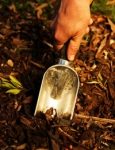
What is good compost?
In the organic gardening world, you’ll often hear “add compost.” But what’s okay compost, what’s good compost, and what’s great compost?
To become a better gardener, I invite you to think about soil and compost from your soil organisms’ point of view.
Like all living organisms, soil critters need Food, Water, Shelter & Protection, and a Place to raise young. This post focuses on the “food” aspect of that jingle.
John Jeavons, author of How to Grow More Vegetables than you can imagine, says:
“Feed your soil. Your soil [organisms] feed your plants, and your plants feed you.”
Compost is food for the vast array of living soil organisms. Decayed or decaying matter — things that used to be plants — keeps the whole ecosystem thriving.
So it follows that if one kind of compost provides great food, it’s better compost. And if another kind of compost provides lesser-quality food, it’s only “okay compost.”
Remember, we’re working with city soils which have been abused. Humans have run bulldozers across our city soils, wiping those spaces clear of all plant life thus disconnecting the soil ecosystems from living plants. In some places, chemicals have been dumped into the soil. Even as gardeners, unknowing folks might stomp on soil with their feet or repeatedly till soil that’s just getting its ecosystem set up.
We have a whole ecosystem to rebuild. That is basically our mission as gardeners, to build up, restore, regenerate and maintain that rich, diverse living ecosystem.
To feed our soil, here’s what we can offer:
Poor Food for soil organisms
- bagged stuff laced with Miracle Gro or other chemicals. The chemical content in these products can be detrimental to any of the precious soil life you’ve already built up in your garden soil. application of this stuff might set you back in your efforts toward soil development.
- bagged “garden soil” product – likely includes other ingredients such as sand or perlite which your garden soil might not need (you should do a soil test to find out), and which dilutes the food aspect of the material you’re applying. it also won’t bring many living soil organisms into your garden.
- bagged “potting soil” product – use potting soil when you’re gardening in containers. if you’re gardening in-ground, see what I said above about “garden soil” product
Okay Food for soil organisms
- purchased bagged “compost” product. this is likely made in an industrial facility. it is okay food if you have an existing population of soil organisms in your garden. however if your garden soil is lean on soil organisms, or you just tilled, or you’re just getting started, see below.
- industrial compost imported by the truckload. if you’re working in a community garden, this might be what the garden provides. the thing about industrial compost is it doesn’t have the rich panorama of soil life.
Best Food for soil organisms
- DIY compost made on-site. examples: home compost bin, community garden compost bin, or trench composting. these are great sources because they bring in the living component of great soil. when you add DIY compost to your soil, you’re also adding a wide diversity of alive soil organisms, egg cases, mycorrhizal spores. think of it like eating yogurt or drinking kombucha for the beneficial cultures.
- worm castings from home worm bins. even if you live in an apartment, you can do worm composting. note that worm castings are very potent and should be diluted before application to the garden.
- compost or worm castings made small-scale by a vendor (example: the guy at Mar Vista Farmers Market)
Elaine Ingham, in her introductory SoilFoodWeb courses, emphasizes that the pinnacle of compost is when there are the most soil organisms alive and active within the composting material. She and her students use a microscope to determine this. Ingham teaches that compost can indeed be overmatured — when it’s black colored and crusty, it is past-prime, it has overmatured, and your soil organisms have begun to die out.
For the very best compost, you want to catch it when it smells rich and healthy, it’s moist and brown, and you might even see soil organisms with the naked eye. That’s when you want to get it into your garden!
Far beyond gardens
Composting isn’t just about gardens. Composting of food and agricultural waste is among the top 100 most powerful climate solutions available to roll back global warming. (Hawken, 2017, p.62)
University researchers like Dr. Wendee Silver and the Marin Carbon Project are studying carbon inputs into the soil (in other words, compost) together with living soil organisms, so that we can optimize this valuable resource.
So, when you participate in composting and restoring living soil, you’re helping put in place a powerful climate solution!
For other soil-related resources, see Resources for my soil-building class
Sources:
- “Food, Water, Shelter & Protection, and a Place to raise young” jingle comes from the National Wildlife Federation’s Backyard Wildlife Habitat program.
- John Jeavons quote is a paraphrasing of what he says in How To Grow More Vegetables plus his Ecology Action publications, interviews and in-person talks.
- Hawken, P. (Ed.). (2017). Drawdown: The Most Comprehensive Plan Ever Proposed to Reverse Global Warming (Illustrated ed.). New York, New York: Penguin Books.
- Compost cycle illustration from Jones, S. & Simple Living Creative Learning. (2019). Composting Life Cycle Printable Pack (pdf). Retrieved January 27, 2022, from https://simplelivingcreativelearning.com/wp-content/uploads/2020/04/Composting-LIfe-Cycle-Printable-Pack-A.pdf

